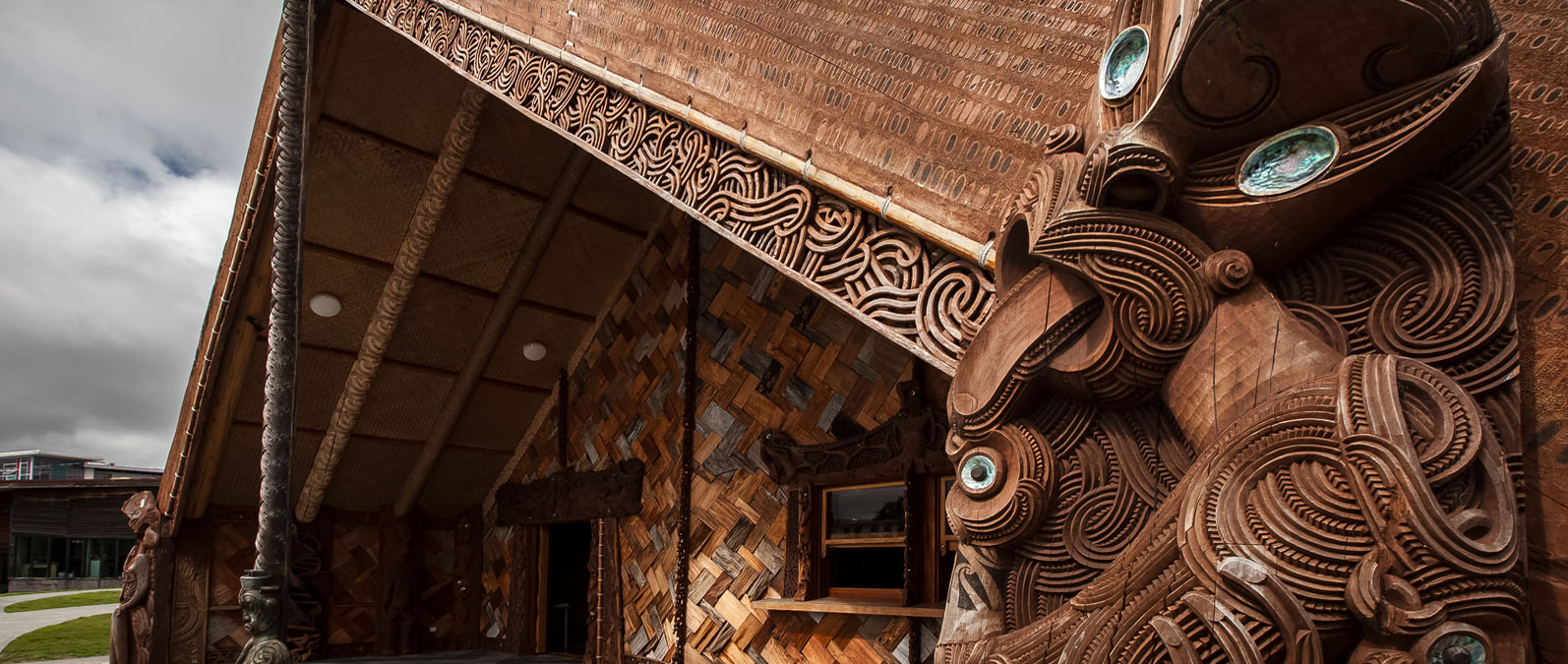He tāpiri taketake he tauira o tōnā wā tonu - Blend of classic and contemporary design
 Lyonel has introduced entirely new concepts by combining traditional techniques with modern media. For example, the whole inside front wall of the wharenui has been created by carving a map of Auckland from medium-density particle board, which appears to be peeling off to reveal the history of the surrounding Mt Albert, Pt Chevalier, Waterview and Carrington areas.
Lyonel has introduced entirely new concepts by combining traditional techniques with modern media. For example, the whole inside front wall of the wharenui has been created by carving a map of Auckland from medium-density particle board, which appears to be peeling off to reveal the history of the surrounding Mt Albert, Pt Chevalier, Waterview and Carrington areas.
For the tāhuhu or ridge pole, which represents the ancestors’ backbone, four logs have been lashed together using traditional waka or canoe joints.

"The carvings may be traditional in format, but each element has been remodelled to fit modern society and to reflect its influences. This marae is a culmination of the past 30 years of my career. It is a legacy to those from whom I have learned," Lyonel says.

Lyonel and his team have been working with passion and dedication to bring to life magnificent new works of art that tell the story of Auckland/Tamaki Makaurau from the earliest settlement to the present day. Everything within the wharenui has an initial point of connection to ancestral or historical themes, then via a chronological sequence more modern stories immerge that relate to more modernistic topics.
The back wall signifies the beginning of this chronology. Moving through the centre of the whare, the central heart pole or poutokomanawa represents the 1840s and the signing of the Treaty of Waitangi. The internal front wall speaks of today via an expanded roadmap that occupies the entire wall. It can be observed that the modern suburban façade is being stripped back to reveal the old landscape still present beneath modern-day Auckland.
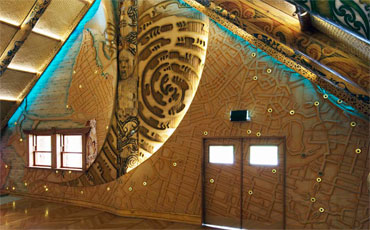
Outside, political, scientific and social comments allude to our vibrant society and the world around us. However the last word or words in this case are incised into the Maihi or barge boards in binary code or computer language. They are in fact the lyrics of a song that offers hope for our future.
Along the back wall of the wharenui, 10 carved figures are set against an arai or veil, delineating the spiritual and physical worlds. In formal oratory the notion of going ‘beyond the veil’ – kua haere ratau ki tua o te arai – is often referred to as a way of illustrating the relationship between the historical and contemporary. This helps to anchor the meeting house in the past. In Unitec’s marae, te ao tawhito or te ao wairua (the spirit world) is comprised of a series of woven and wooden panels, approximately 3m high by 1m wide, forming a layered ‘welcoming committee’ or paepae whakatau. The effect has been achieved by adhering the woven flax whariki to carved moulds via a vacuum process courtesy of Unitec’s boatbuilding department.
Arranged chronologically around the main walls, each carved panel or poupou tells a different story, aiming to stimulate discussion and learning, rather than present a fixed viewpoint. Totara is the main timber used in the carvings, and, to a lesser extent, matai on the floors and in other ancillary joinery.

One of the early poupou, a lizard disappearing under the surface of the timber refers to Ruarangi, one of the earliest settlers and a great chief of the Turehu people. Ruarangi was born in Auckland around 1300 at a time when the many lava caves in the ōwairaka (Mt Albert) area – which were often inhabited by lizards, bats etc – were used as escape routes and to shelter from the sun.
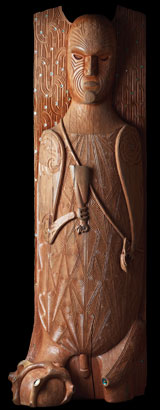
Another influential warrior figure, Hongi Hika, is portrayed carrying a musket butt in place of the traditional patu or short hand club. Hongi was active prior to and around the signing of the Treaty of Waitangi, at a time when guns were first introduced to New Zealand. This poupou symbolises both a time of war but also of the formation of new iwi connections through the implementation of new technologies, intermarriage and evolving social alliances.
One of the later poupou serves as the physical manifestation of Unitec’s Te Noho Kotahitanga document – featuring jigsaw pieces that represent the many different people that make up society and the community associated with this marae. Visible across the jigsaw is a tekoteko figure that echos the figure atop the wharenui - 'He Mihi' literally personifies the moment of encounter between those who meet. As a result of some of these encounters it could be said that the mana of this marae belongs to all different cultures.
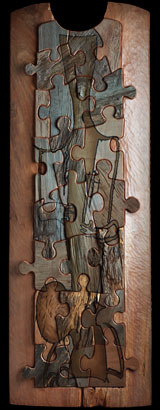
The only poupou without any carvings refers to the block of land called ‘Heruiwi’ from within the Whirinaki Forest where the logs used for the carvings were gifted by Ngāti Manawa/Ngāti Whare to Lyonel Grant for the construction of Unitec’s marae. The Heruiwi block is part of a land transfer some 50 years ago. When the local tribes relinquished ownership of Heruiwi for other land in the Whirinaki, it was subsequently cleared in the 1960s. This poupou is indicative of our attitudes around conservation at that time. Not long after that the Government signalled that the milling of native forests would soon come to an end.
Most of the weaving across the wharenui was completed by Unitec weaving tutor Judy Robson-Deane (Te Rarawa) and Shona Tawhiao (Ngai Te Rangi), with help from past weaving students and several Northland weavers who worked on the weaving between the poupou and the kakaho panels. On the back wall alone there are nearly 28,000 strips of flax, while the front wall features weaving that is layered in a special way to symbolise waves and the sea.
Ariā pāpaku, whakapaipai whenua rōnaki - Low impact, eco-sustainable landscaping
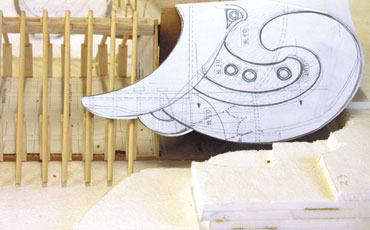
The marae has been recessed into the land, another marae tradition which has fallen away in more recent times.
"I am creating a landscape design that will incorporate Maori studies and surrounding natural features," says Lyonel.
As part of stage two of the project, the marae will be surrounded by an energy-efficient "working landscape" that will develop the natural habitat and promote climatic cooling. It will make use of recycled, locally sourced and low-energy materials as well as low-maintenance planting and sculptured "rain gardens", to help increase awareness of the need for water and energy conservation, and other environmental issues.
The completed marae will also feature a "green roof", shaped like a giant manaia figure that will dominate the site. The roof will provide a habitat for birds and insects, improve air quality and reduce stormwater runoff by 75 percent.

